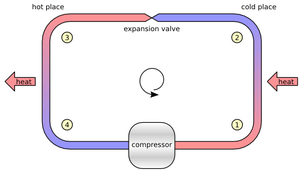Refrigeration plant

A refrigeration plant uses gas, liquid, and mechanical energy to move heat from one place to another. A liquid, such as ammonia, which has a low boiling temperature is allowed to pass into a space via tubing. As the pressure in the ammonia drops, the liquid begins to boil, and enter a phase transition from liquid to gas. In doing so, there is a great absorption of heat energy by the liquid in the tubing to create this phase change. The heat energy is absorbed from the space, and as the liquid boils off, it forms a gas. The gas is pulled through the tubing in the space into a suction header outside the space to the suction of a compressor. The compressor repressurises the gas, and discharges the liquid through cold water heat exchangers or cooling fans, exhausting the heat absorbed from the space, into the outside atmosphere. By pressurising and cooling the gas, the gas returns to a liquid stage, where it is stored and reintroduced to the space to be cooled.